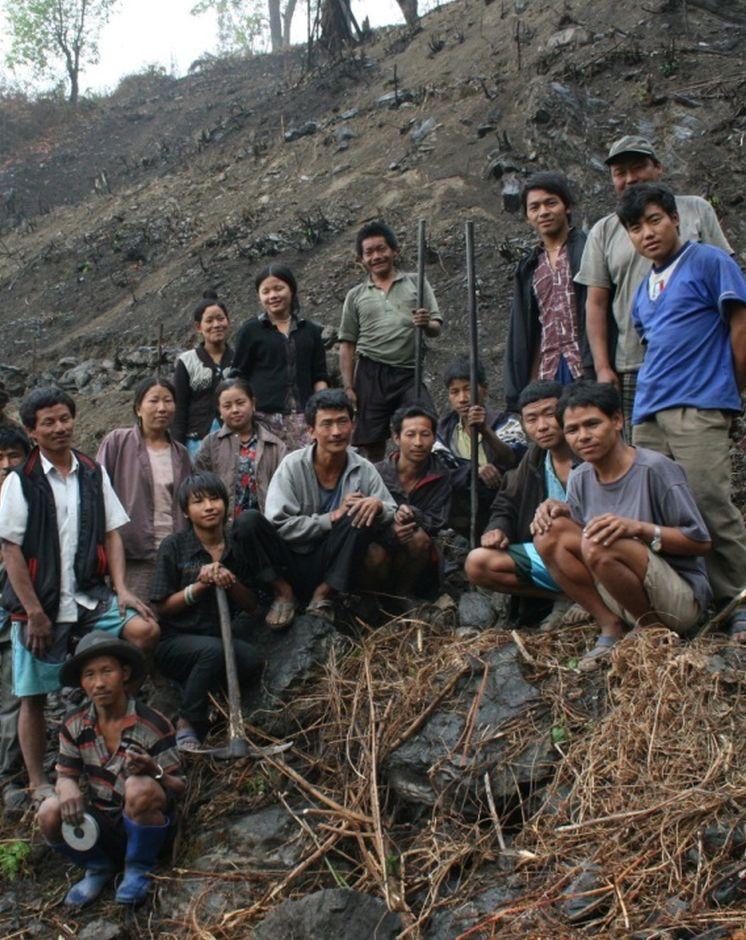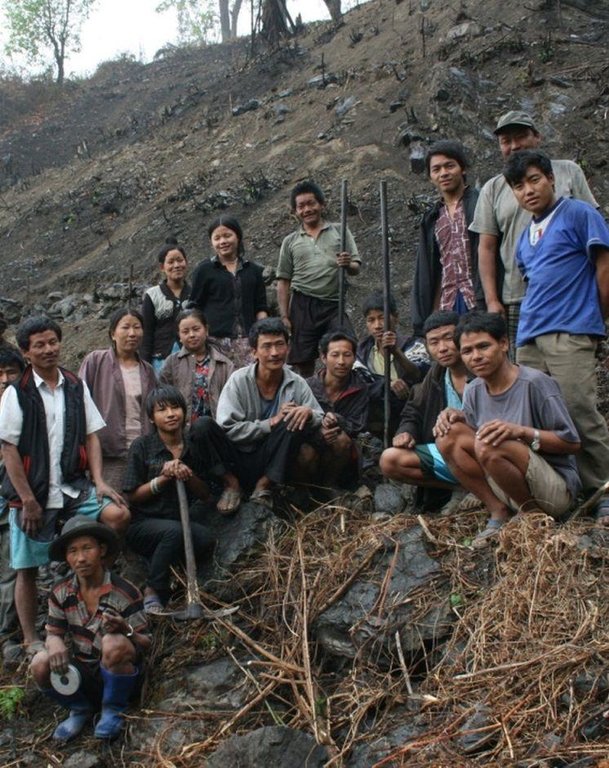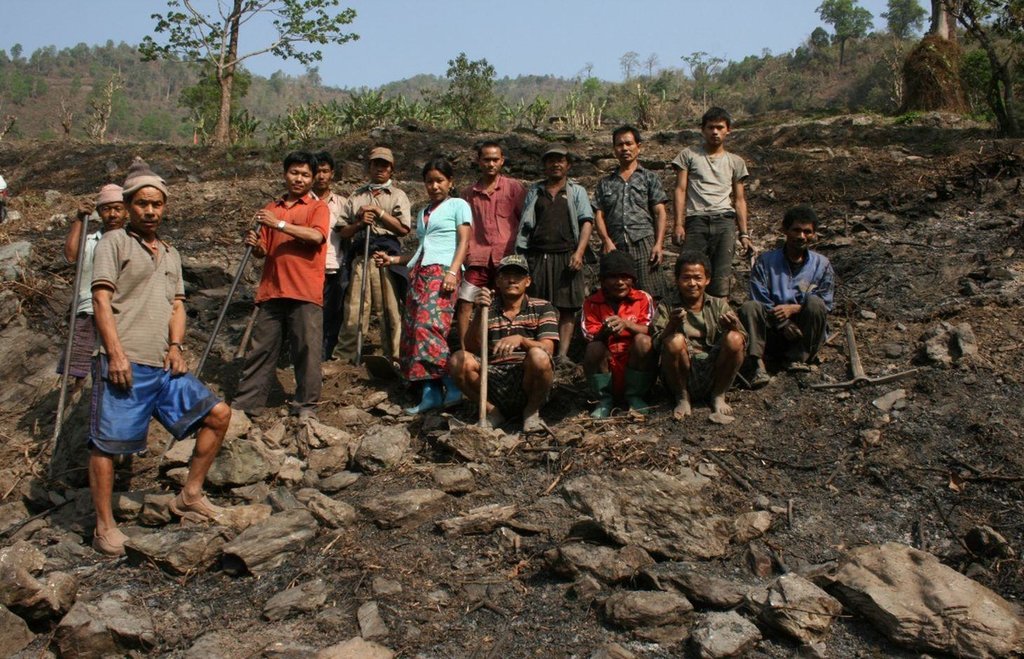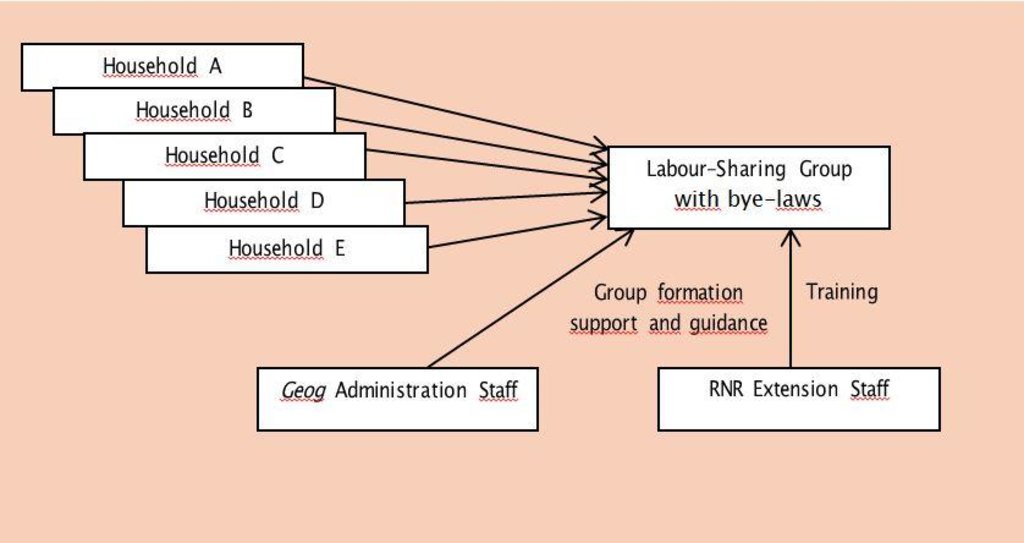SLM Labour-Sharing Group [Bután]
- Creación:
- Actualización:
- Compilador: Karma Dorji
- Editor: –
- Revisor: Fabian Ottiger
approaches_2491 - Bután
Visualizar secciones
Expandir todo Colapsar todos1. Información general
1.2 Detalles de contacto de las personas de referencia e instituciones involucradas en la evaluación y la documentación del Enfoque
Nombre de la(s) institución(es) que facilitaron la documentación/ evaluación del Enfoque si fuera relevante)
MoA (MoA) - ButánNombre de la(s) institución(es) que facilitaron la documentación/ evaluación del Enfoque si fuera relevante)
National Soil Services Centre (National Soil Services Centre) - Bután1.3 Condiciones referidas al uso de datos documentados mediante WOCAT
¿Cuándo se compilaron los datos (en el campo)?
21/03/2011
El compilador y la/s persona(s) de referencia claves aceptan las condiciones acerca del uso de los datos documentados mediante WOCAT :
Sí
1.4 Referencia/s al/los Cuestionario(s) de Tecnologías MST
2. Descripción del Enfoque MST
2.1 Breve descripción del Enfoque
Labour-sharing group at village and sub-village level to ease the labour constraint faced by many households.
2.2 Descripción detallada del Enfoque MST
Descripción detallada del Enfoque MST:
Aims / objectives: A labour-sharing group is a pool of land-users, who work on rotation basis on the plots of the different group members and replaces the conventional approach of an individual land user carrying out a specific SLM intervention. An important constraint for effective implementation of SLM interventions is the lack of sufficient labour force at household level. To tackle this key issue, groups are formed at village and sub-village level to enable these households to take up the relatively labour-intensive SLM activities, such as stone bunding, bench terracing, stone check dam construction, water source protection works or grass hedgerow development.
Methods: The labour-sharing group is given an initial practical training on the basics of the SLM intervention, which start with hands-on work on the land of a group member, preferably that of a vulnerable household, which otherwise would have difficulty to provide sufficient labour to take up the activity. Labour-sharing groups therefore facilitate the inclusion of vulnerable households, especially female-headed and small families, in the implementation of labour-intensive SLM inter-ventions. In addition to the technical guidance provided by the extension staff, support is given to the group formation process, such as drafting of informal by-laws and group management.
Stages of implementation: Labour-sharing groups enable households to carry out key SLM interventions more effectively and efficiently enabling them to cover as compared to individual household approach. Other co-benefits reported are the improved community sense and enhanced social cohesion, because the exchange of experiences and collaboration builds mutual trust. Working in a group eases hard physical work, such as carrying and breaking large boulders and is perceived to be much more enjoyable than working alone or in a small household setting.
Role of stakeholders: Groups that were formed for the implementation of a specific SLM activity often continue carrying our other planned SLM interventions in a group. In some villages communities reported that they had lost the former practice of labour-sharing, but that with reintroduction by the project their community sense has been rejuvenated. Sustainability of the labour-sharing approach has to be proven post-project. Additional costs are very limited and are restricted to group formation guidance and some additional group support, such as tool sets and more incentives as more land will be converted by the group approach.
2.3 Fotos del Enfoque
2.5 País/ región/ lugares donde el Enfoque fue aplicado
País:
Bután
Región/ Estado/ Provincia:
Chhukha Dzongkhag
Especifique más el lugar :
Logchina geog, Amallay chiog
2.6 Fechas de inicio y conclusión del Enfoque
Indique año del inicio:
2009
Año de conclusión (si el Enfoque ya no se aplica):
2012
2.7 Tipo de Enfoque
- proyecto/ basado en un programa
2.8 Propósitos/ objetivos principales del Enfoque
The Approach focused on SLM only
- To ease the existing labour constraint of individual households by pooling labour force into a common pool, ensuring a more time-efficient labour approach, enabling the group to convert larger areas of land.
- To facilitate the inclusion of vulnerable households in more labour-intensive long-term SLM interventions, for which they otherwise would not have the meansto participate.
- To improve community cohesion through improved trust, understanding, social fencing and “labour joy” (“it is much more fun to work in a group than to sweat individually”).
The SLM Approach addressed the following problems: - SLM interventions, as prioritized in chiog SLM action plan, are very labour-intensive, while labour is increasingly becoming a serious constraint in many rural areas of Bhutan, because of rural-urban migration, off-farm labour and other developmental activities.
- Vulnerable households, single-headed families and poorest families, have often the most difficulty providing sufficient labour for long-term SLM interventions
- Communities often face problems in achieving the targeted area of land to be converted to a more sustainable SLM practice, because of labour shortage.
2.9 Condiciones que facilitan o impiden la implementación de la/s Tecnología/s aplicadas bajo el Enfoque
normas y valores sociales/ culturales/ religiosos
- impiden
Some issues with households who do not share sufficient labour / fail to show up
Treatment through the SLM Approach: Informal by-laws, penalty system, social fencing
marco de trabajo legal (tenencia de tierra, derechos de uso de tierra y agua)
- facilitan
The existing land ownership, land use rights / water rights greatly helped the approach implementation: Individual titled land tenure greatly facilitates motivation and commitment of households to participate in group approach as they are direct beneficiaries.
carga de trabajo, disponibilidad de mano de obra
- impiden
SLM interventions often require considerable hard physical labour, in a society where labour force increasingly is becoming scarcer.
Treatment through the SLM Approach: Pool individual households in a group and work on rotation basis on each other’s land
3. Participación y roles de las partes interesadas involucradas
3.1 Partes interesadas involucradas en el Enfoque y sus roles
- usuarios locales de tierras/ comunidades locales
self initiative during planning cycle
Slight differences in participation level in the most physically challenging activities such as stone bunding, but also partly culturally determined if there is gender bias in participation. In less physically demanding activities participation is equally divided.The most vulnerable households are included in the labour-sharing group, just as the “better off” families; inclusion of vulnerable households is definite advantage of approach, and an important objective.
- especialistas MST/consejeros agrícolas
- gobierno local
Local government (geog staff, chiog representatives) and local community
- gobierno nacional (planificadores, autoridades)
3.2 Involucramiento de los usuarios locales de tierras/ comunidades locales en las distintas fases del Enfoque
| Involucramiento de los usuarios locales de tierras/ comunidades locales | Especifique quién se involucró y describa las actividades | |
|---|---|---|
| iniciación/ motivación | interactivo | Participatory SLM Action Planning |
| planificación | interactivo | Participatory SLM Action Planning; Schedule of rotation compiled by group members |
| implementación | interactivo | Training / capacity building at kick-off of group formation process; stone bunding, hedgerow establishment, bench terracing, stone check dam construction, bamboo and tree plantation, water source protection works and grass strip establishment |
| monitoreo y evaluación | interactivo | Participatory Monitoring & Evaluation meetings to give feedback and make adjustments / give guidance |
| Research | ninguno |
3.3 Flujograma (si estuviera disponible)
Descripción:
Labour-sharing group and its governance
Autor:
Hans van Noord (Schoutenkamp 43 Heteren The Netherlands)
3.4 La toma de decisiones en la selección de Tecnología(s) MST
Especifique quién decidió la selección de las Tecnología/ Tecnologías a implementarse:
- principalmente usuarios de tierras con el apoyo de especialistas MST
Explique:
Decisions on the method of implementing the SLM Technology were made by mainly by land users supported by SLM specialists
4. Apoyo técnico, fortalecimiento institucional y gestión del conocimiento
4.1 Construcción de capacidades / capacitación
¿Se proporcionó la capacitación a usuarios de tierras/ otras partes interesadas?
Sí
Especifique quién fue capacitado:
- usuarios de tierras
Forma de capacitación:
- en el contexto de trabajo
- de agricultor a agricultor
- áreas de demostración
Temas avanzados:
Training programme for specific SLM interventions, carried out by the labour-sharing group after initial capacity building and hands-on practice sessions; additional group formation support and guidance by the municipality administration staff and extension staff.
4.2 Servicio de asesoría
¿Los usuarios de tierras tienen acceso a un servicio de asesoría?
Sí
Especifique si servicio proporcionado se realizó:
- en los campos de los usuarios de tierras
- en centros permanentes
Describa/ comentarios:
Name of method used for advisory service: Group formation process guidance; Key elements: by-law formulation, demo trainings, exchange visit; By extension staff and geog administration staff in group formation process and during ad hoc visits and regular participatory M & E meetings.
Advisory service is quite adequate to ensure the continuation of land conservation activities; Some need for refreshing/additional training of SLM techniques
4.3 Fortalecimiento institucional (desarrollo institucional)
¿Se establecieron o fortalecieron instituciones mediante el Enfoque?
- sí, mucho
Especifique el nivel o los niveles en los que se fortalecieron o establecieron las instituciones:
- local
Especifique el tipo de apoyo:
- financiero
- construcción de capacidades/ entrenamiento
- equipo
Proporcione detalles adicionales:
Group formation process guidance: training and continued support by extension and geog administration staff.
4.4 Monitoreo y evaluación
¿El monitoreo y la evaluación forman parte del Enfoque?
Sí
Comentarios:
bio-physical aspects were regular monitored by project staff, government, land users through measurements; indicators: Regular measurements by project staff and group members: area converted, of dams built etc.
technical aspects were regular monitored by project staff, government, land users through observations; indicators: Regular observations by project staff and group members: implementation according to technical guidelines (distances between bunds/hedges, survival rate of seedlings etc.
socio-cultural aspects were regular monitored by project staff, government, land users through observations; indicators: Regular observations by project and geog administration staff and group members regarding group functioning and possible conflicts (drafting of by-laws, rules etc.)
economic / production aspects were regular monitored by project staff, land users through measurements; indicators: Regular measurements by project staff and group members: crop yield, production area increase
area treated aspects were regular monitored by project staff, land users through measurements; indicators: Regular measurements by project staff and group members: area treated
no. of land users involved aspects were None monitored by project staff, land users through measurements; indicators: Regular measurements by project staff and group members: # of households
management of Approach aspects were None monitored by project staff, government, land users through observations; indicators: Regular M & E meetings with project and geog administration staff and group members
There were few changes in the Approach as a result of monitoring and evaluation: Drafting and adoption of group by-laws to regulate agreements and as enforcement of “social fencing”
There were few changes in the Technology as a result of monitoring and evaluation: slight changes in technical guidelines after group feedback.
5. Financiamiento y apoyo material externo
5.1 Presupuesto anual para el componente MST del Enfoque
Si no se conoce el presupuesto anual preciso, indique el rango:
- < 2,000
Comentarios (ej. fuentes principales de financiamiento/ donantes principales):
Approach costs were met by the following donors: government (SLMP project support: tools, training, incentives): 5.0%; local community / land user(s) (labour contribution): 95.0%
5.2 Apoyo financiero/material proporcionado a los usuarios de tierras
¿Los usuarios de tierras recibieron financiamiento/ apoyo material para implementar la Tecnología/ Tecnologías? :
Sí
Si respondió sí, especifique el tipo o los tipos de apoyo, condiciones y proveedor(es) :
Incentive per area converted to sustainable SLM practice and seeds/seedlings.
5.3 Subsidios para insumos específicos (incluyendo mano de obra)
- equipo
| Especifique qué insumos se subsidiaron | En qué grado | Especifique los subsidios |
|---|---|---|
| herramientas | totalmente financiado | |
- agrícola
| Especifique qué insumos se subsidiaron | En qué grado | Especifique los subsidios |
|---|---|---|
| semillas | parcialmente financiado | maize, mustard, potato, wheat, paddy, vegetables |
Comentarios:
Incentives cover mainly labour contribution as provided by the group members and is mostly only a minor fraction of the actual labour costs.
5.4 Crédito
¿Se proporcionó crédito bajo el Enfoque para actividades MST?
No
6. Análisis de impacto y comentarios de conclusión
6.1 Impactos del Enfoque
¿El Enfoque ayudó a los usuarios de tierras a implementar y mantener Tecnologías MST?
- No
- Sí, un poco
- Sí, moderadamente
- Sí, mucho
Labour-sharing has resulted in the possibility to convert/treat larger areas per working day and has made the work much easier (lifting of heavy stones etc.). More land has now become cultivated through labour-sharing group involvement as could have been done through individual households.
¿El Enfoque empoderó a grupos en desventaja social y económica?
- No
- Sí, un poco
- Sí, moderadamente
- Sí, mucho
Targeted inclusion of vulnerable households in group, even if they have not sufficient labour to contribute to labour pool; hands-on training starts on land of most vulnerable/poor households to give them first benefit.
Did other land users / projects adopt the Approach?
- No
- Sí, un poco
- Sí, moderadamente
- Sí, mucho
Other villages have followed the example of the initial groups.
Did the Approach lead to improved livelihoods / human well-being?
- No
- Sí, un poco
- Sí, moderadamente
- Sí, mucho
Group members express satisfaction over improved social cohesion and interaction because of built trust and understanding and social bonding; group work has contributed to enhanced food self-sufficiency.
Did the Approach help to alleviate poverty?
- No
- Sí, un poco
- Sí, moderadamente
- Sí, mucho
Through improved food self-sufficiency, increased production area/improved cropland area and targeted inclusion of most vulnerable households that otherwise could not have participated in specific labour-intensive SLM activity
6.2 Motivación principal del usuario de la tierra para implementar MST
- producción incrementada
- carga de trabajo reducida
- pagos/ subsidios
- afiliación al movimiento/ proyecto/ grupo/ redes
- conciencia medioambiental
6.3 Sostenibilidad de las actividades del Enfoque
¿Pueden los usuarios de tierras sostener lo que se implementó mediante el Enfoque (sin apoyo externo)?
- sí
Si respondió que sí, describa cómo:
Existing group approach seems well suited to continue post-project, also as it partly is a rejuvenated traditional practice to share labour in a community group.
6.4 Fortalezas/ ventajas del Enfoque
| Fuerzas/ ventajas/ oportunidades desde la perspectiva del usuario de la tierra |
|---|
|
Eases work (breaking stones, carrying etc.). A-frame running helps to have better lines. Continuous smooth work wit many Social cohesion / experience sharing (How to sustain/ enhance this strength: Continuation of group work Continuation of group work Continued group monitoring and guidance) |
| Fuerzas/ ventajas/ oportunidades desde la perspectiva del compilador o de otra persona de referencia clave |
|---|
|
Tackles main issue of labour shortage and eases hard physical work (breaking stones, carrying/lifting boulders etc.) Enhances social cohesion and group spirit / community sense; promotes exchange of experiences Facilitates conversion of larger areas of slope segments treated with SLM practices Preferred approach to enhance inclusion of most vulnerable households in labour-intensive SLM practices (How to sustain/ enhance this strength: Continued group monitoring and guidance Continued group monitoring and guidance Continued group monitoring and guidance Start hands-on training work on land of these vulnerable households to give them first benefit) |
6.5 Debilidades/ desventajas del Enfoque y formas de sobreponerse a ellos
| Debilidades/ desventajas/ riesgos desde la perspectiva del usuario de la tierra | ¿Cómo sobreponerse a ellas? |
|---|---|
| Some conflicts in labour-sharing (after completion on their land they abscond). | Attendance register, social control, labour compensation, fines, by-laws. |
| Debilidades/ desventajas/ riesgos desde la perspectiva del compilador o de otra persona de referencia clave | ¿Cómo sobreponerse a ellas? |
|---|---|
|
Sustainability has yet to be proven post-project; certain dependency on incentives Loose group structure without formal leadership might threaten sustainability |
Continued group monitoring and guidance by extension and geog administration staff By-laws to formalize some agreements and enforce some penalties |
7. Referencias y vínculos
7.1 Métodos/ fuentes de información
- visitas de campo, encuestas de campo
- entrevistas con usuarios de tierras
Vínculos y módulos
Expandir todo Colapsar todosVínculos
No hay vínculos
Módulos
No se hallaron módulos






